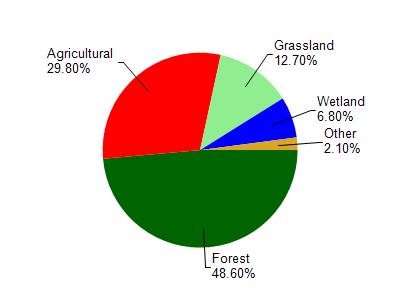Jackson
Yes
No
No
Fish and Aquatic Life
Overview
This two-mile long trout stream supports a Class I brook trout fishery. One half of the stream is well protected with native vegetation and runs narrow and deep. The other half of the stream is degraded by livestock pasturing the streambanks and runs wide and shallow providing limited trout habitat.
Date 2001
Author Aquatic Biologist
General Condition
One half of this Class I Coldwater Trout stream is well protected with native vegetation and runs narrow and deep. The other half of the stream is degraded by livestock pasturing the streambanks and runs wide and shallow providing limited trout habitat.
Date 2010
Author Aquatic Biologist
Condition
Wisconsin has over 84,000 miles of streams, 15,000 lakes and milllions of acres of wetlands. Assessing the condition of this vast amount of water is challenging. The state's water monitoring program uses a media-based, cross-program approach to analyze water condition. An updated monitoring strategy (2015-2020) is now available. Compliance with Clean Water Act fishable, swimmable standards are located in the Executive Summary of Water Condition in 2018. See also the 'monitoring and projects' tab.
Reports
Recommendations
Protect Riparian or Shorelands
A portion of the stream is degraded by livestock pasturing streambanks and runs wide and shallow providing limited trout habitat. Efforts should be made to reduce access to the stream and protect the shoreline.
Management Goals
Wisconsin's Water Quality Standards provide qualitative and quantitative goals for waters that are protective of Fishable, Swimmable conditions [Learn more]. Waters that do not meet water quality standards are considered impaired and restoration actions are planned and carried out until the water is once again fishable and swimmable
Management goals can include creation or implementation of a Total Maximum Daily Load analysis, a Nine Key Element Plan, or other restoration work, education and outreach and more. If specific recommendations exist for this water, they will be displayed below online.
Monitoring
Monitoring the condition of a river, stream, or lake includes gathering physical, chemical, biological, and habitat data. Comprehensive studies often gather all these parameters in great detail, while lighter assessment events will involve sampling physical, chemical and biological data such as macroinvertebrates. Aquatic macroinvertebrates and fish communities integrate watershed or catchment condition, providing great insight into overall ecosystem health. Chemical and habitat parameters tell researchers more about human induced problems including contaminated runoff, point source dischargers, or habitat issues that foster or limit the potential of aquatic communities to thrive in a given area. Wisconsin's Water Monitoring Strategy was recenty updated.
Grants and Management Projects
| Project Name (Click for Details) | Year Started |
|---|
|
|
Monitoring Projects
| WBIC | Official Waterbody Name | Station ID | Station Name | Earliest Fieldwork Date | Latest Fieldwork Date | View Station | View Data |
|---|
| 1807000 | Amo Creek | 10007623 | Amo Creek at Cth F | 9/9/1996 | 9/9/1996 | Map | Data |
| 1807000 | Amo Creek | 10007624 | Amo Creek at South Alma Rd | 9/9/1996 | 1/1/2015 | Map | Data |
|

Watershed Characteristics
Amo Creek is located in the Upper Trempealeau River watershed which is 175.54 mi². Land use in the watershed is primarily forest (48.60%), agricultural (29.80%) and a mix of grassland (12.70%) and other uses (8.90%). This watershed has 359.69 stream miles, 209.54 lake acres and 7,549.82 wetland acres.
Nonpoint Source Characteristics
This watershed is ranked Not Available for runoff impacts on streams, Not Available for runoff impacts on lakes and High for runoff impacts on groundwater and therefore has an overall rank of High. This value can be used in ranking the watershed or individual waterbodies for grant funding under state and county programs.However, all waters are affected by diffuse pollutant sources regardless of initial water quality. Applications for specific runoff projects under state or county grant programs may be pursued. For more information, go to surface water program grants.